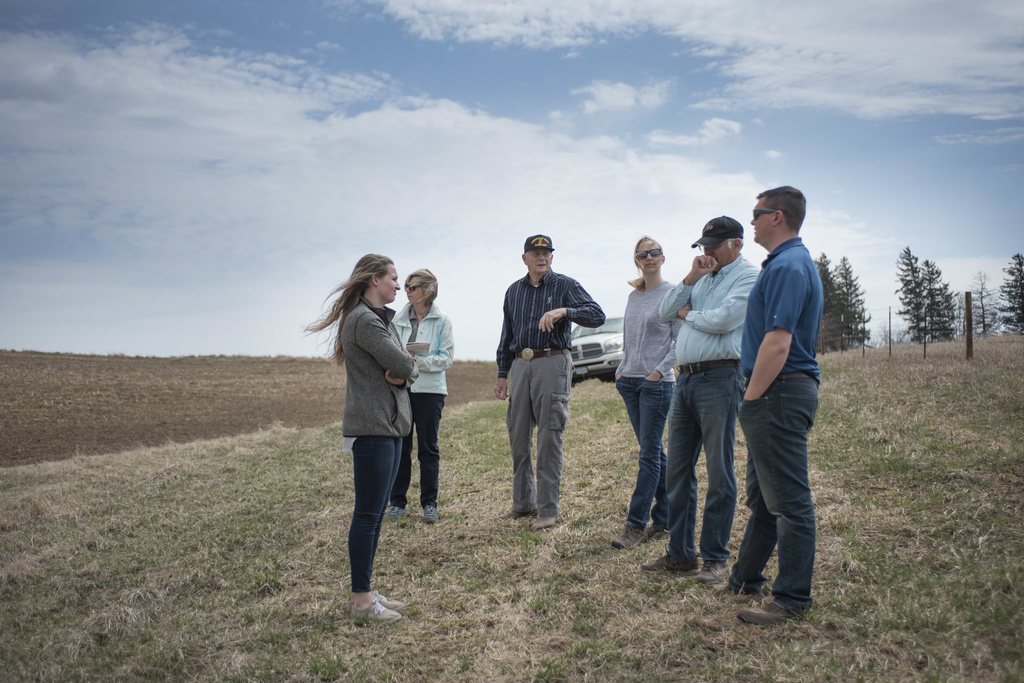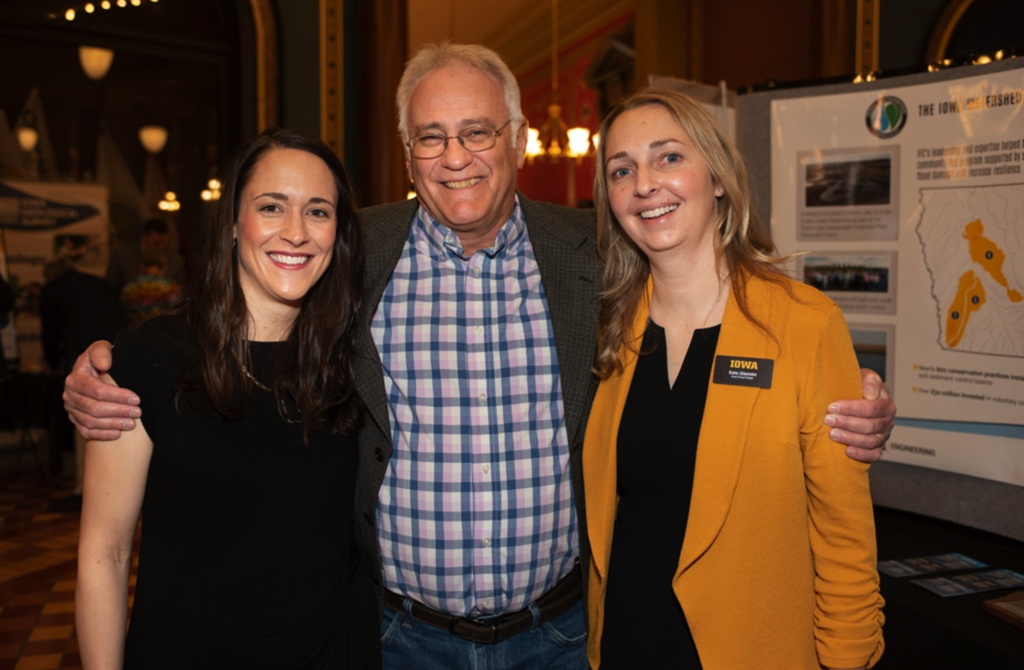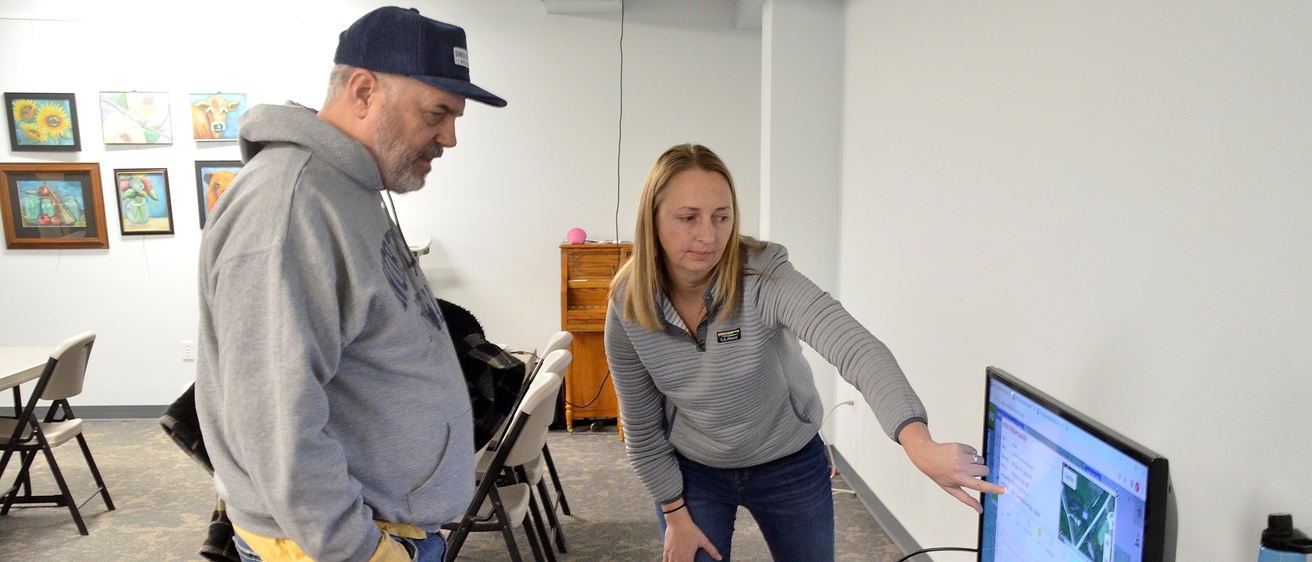Kate Giannini, program manager at the Iowa Flood Center, served as a 'community connector' working with Northeast Iowa Resource Conservation & Development (NEIARCD) and the Turkey River Watershed Management Authority (TRWMA) on a community engagement project titled Building Connected Communities in Rural Watersheds: Collaborative Partnerships for Actionable Science. The project aimed to educate and empower members of the community living in the Turkey River Watershed to share their stories while exploring new ways to protect and preserve the water resources vital to the productivity of farmland, the safety of drinking water, and beauty of shared recreation areas.

"I can't say enough positive things about this community engagement work," Giannini said. "It builds our network, reinforces the importance of relating our research into impactful on-the-ground projects, and especially provides resources to communities that don't have them. This work has been incredibly impactful to our smaller communities and the Iowans we serve."
For this project, the Iowa Flood Center worked with the Turkey River Watershed, the University of Iowa and the Iowa Flood Center, and the NEIARCD. Together these organizations are focused on advancing education and awareness in communities to improve land resiliency through flood reduction, conservation practices, and water quality improvement, which helps recovery when extremes from floods, droughts, and climate change impact land.
"We are working with farmers, landowners, watershed management authorities, and local community partners to provide better tools and resources for them to make decisions that work for them on their property," Giannini said.
A watershed is an area of land that drains to a local water body, which could be a lake, river, or small creek, which all vary in different sizes. When it rains in urban areas, water that falls on private property goes down a storm drain and into a nearby local creek. In rural communities, those who farm in the watershed with lots of land to manage can influence what helps or impacts people downstream based on what they do on their land.
"It's really about bridging that gap between downstream stakeholders, what's happening on the land, what type of management systems are in place, and how they are affecting somebody else downstream either positively or negatively," Giannini said. "Somebody living downstream in a watershed might not know the land near Minnesota shares the same watershed. They appreciate learning about the land impacting water in their area."
BUILDING COMMUNITY THROUGH STORYTELLING
"Many people assume that a watershed community means living in a floodplain and automatically say, 'I don't live in a watershed,'" Giannini said. "They are thinking of being affected by floods – especially if the Iowa Flood Center is there talking about tools and resources. Once people learn that this is the only land that drains to the Turkey River, they appreciate having that terminology and connecting the dots."

The Iowa Flood Center worked with the NEIARCD and the TRWMA to conduct a series of planning exercises, workshops, and community meetings to gain a better perspective of those living, working, and playing in the Turkey River Watershed while raising awareness among community members who might not know that they live in a watershed or what that means for their lives and the environment.
"We wanted to create a sense of community at the watershed level and better educate the stakeholders there so they could learn about available resources, other projects that are occurring, and what we can all do to reduce flooding and improve water quality - in addition to learning about other resources that the Iowa Flood Center and the University of Iowa are already providing," Giannini said.
The project invited members of the community to drop in to 'open house' style events, where whiteboards were available for people to write about personal experiences within the Turkey River, challenges they faced living and working on the land, and ideas that they had, including improving water quality and recreational access.
"Watershed management has been a core strength of our team," said Ross Evelsizer, natural resource project director at NEIARCD. "However, engaging with the University of Iowa and the Iowa Flood Center has elevated our access to resources, funding, and community impact. This project will set a foundation among stakeholders and improve the sense of community at the watershed scale."
Giannini[GKM1] also set up an Iowa Flood Center booth with a monitor displaying tools and resources provided by the University of Iowa that community members can access. Attendees could interact with the information system and point out where they lived and worked, along with areas they enjoyed on the Turkey River, on a map and then have deeper conversations about their experiences.
"The storytelling happened in two different ways," Giannini said. "One was listening to stakeholders as they arrived, writing out their stories on boards if they felt comfortable, or sharing them with NEIARDCD staff who would summarize them once they returned to the office. The other involved filling out a paper survey, mailing it in, or completing one online. NEIARCD is working on putting those stories together into an online database."
Once all that information is gathered and processed, NEIARCD will produce a report with appendices that gather everything from the survey results and feature quotes and stories to be shared publicly by summer 2023.
TRWMA will also be using a recently received honorarium for education purposes, inspired by an award NEIARCD received for a recycling education cartoon series. The two organizations decided to create a watershed flooding educational cartoon which they are looking forward to sharing with the community soon.
NEIARCD also received the 2023 Iowa & Minnesota Campus Compact Presidents' Community Partner Award for their passionate focus on developing mutually beneficial projects with the people of Iowa.
"When I learned about the Campus Compact award, I was delighted that they won because they are well-deserving, especially with the numerous watershed projects they have worked on over the past two decades," Giannini said. "The Turkey River isn't the only watershed they are involved with; they have developed online watershed management plans for others in Iowa and serve as project coordinators. They engage with many different audiences, stakeholders, and educators within Northeast Iowa. I was happy to see them acknowledged for their efforts in the community."
A HISTORY OF IMPACT AND ENGAGEMENT
Giannini had previously worked with NEIARCD and TRWMA on a draft grant proposal two years prior with elements of the Connected Communities project.

"We were looking for other funding resources to knock off tasks from that original grant proposal," Giannini said. "An Office of the Vice President for Research (OVPR) grant became available and seemed to fit the bill of what we were trying to do at a smaller scale in the watershed area."
The TRWMA was formed in 2012 and is a newer governance mechanism created by the Iowa legislature in 2010 which gives counties, cities, and soil and water conservation districts a space to create an agreement and work across political boundaries at the watershed level. The Turkey River has close to 30 entities that are current members of the TRWMA and participate in the governance system to collaborate across the watershed.
"Currently in the state of Iowa, there are 27 watershed authorities, of which the TRWMA is one of the first established and is a showcase piece among all the other water management authorities in the state," Giannini said. "Over 40% of the state is covered by watershed authorities."
The TRWMA board meets quarterly and works with NEIARCD. This nonprofit organization works on several environmental and community projects in the area and assists the board with administrative support to advances objectives in the Turkey River Watershed.
"The Turkey River Watershed Management Authority has had a long history of partnering with the University of Iowa and Iowa Flood Center," said Rod Marlatt, board chair at the TRWMA. "We know we can be more resilient in our watershed through flood reduction and water quality improvement projects. The approach of this project is critical to better understanding our watershed community and will improve decision-making that bridges our downstream and upstream communities."
